The Jaguar C-X16 Concept: The Evolution of Hybrid
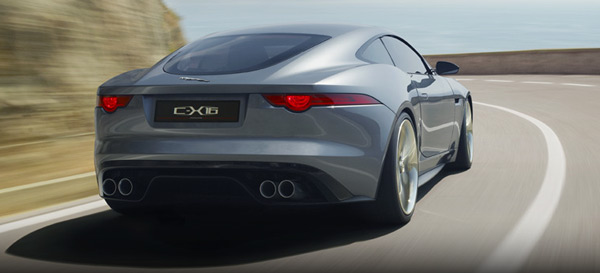
The Jaguar C-X16 concept, set to be debuted at the Frankfurt IAA Auto Show, is a bold statement of Jaguar’s future design and technological intent. A concept ‘One plus One’ sports car that explores future performance hybrid options, the C-X16’s seductive looks, the experimental high-performance hybrid system which boosts output by 94HP (70kW) and 173 lb-ft (235 Nm), and an eye-popping top speed of 186 mph are but a few of the indications that this is an evolution of the hybrid’s direction.
According to Jaguar’s Global Brand Director, Adrian Hallmark, “The C-X16 is our compelling vision for a 21st century Jaguar sports
car. It embodies the established Jaguar strengths of sensual design,
animal-like agility and inspirational performance and combines these
with attributes that set us on a course to create sustainable sports
cars of the future.”
The C-X16 takes the traditional front-engined, rear-wheel drive formula
that Jaguar defined over the decades and reinvents it for the 21st
Century in a performance-oriented hybrid drivetrain with 50:50 weight
distribution.
The latest iteration of Jaguar’s ‘Redefining Performance’ ethos, the
system is based around a prototype supercharged all-alloy V6 which
produces 375HP (280kW) and 332lb-ft of torque from 3.0-liter V6.
Supplementing this is an electric motor producing up to 94HP and
173lb-ft of torque, available to the driver at the push of a
steering-wheel boost button.
Allied to an eight-speed gearbox and mounted in a lightweight aluminum
chassis this allows the C-X16 to sprint to 62 mph (100 kmh) in 4.4
seconds.
The aluminum bodywork is wrapped as closely to these mechanicals as
possible to distil the essence of Jaguar sports cars into the next
evolution of an already award-winning design language. By stretching the
main feature lines back from the focal point formed by the grille and
pushing the wheels as far into the corners as possible, the car has a
taut, poised-for-action stance that is unmistakably Jaguar.
The interior showcases important future technologies such as multimodal
rotary controls that incorporate miniature OLED screens, which
reconfigure to reflect the different functions that can be performed via
the controls, all of which are designed for maximum compatibility
between sports car needs and everyday usability.
An example of this is the full smartphone integration via the ‘Connect
and View’ system by which the central TouchScreen reconfigures to mimic
the screen of a connected device. The central screen also features a
second-generation interface with fingertip touch supplemented by buttons
that provide short cuts to top-level menu functions.
As expected from Jaguar, premium materials are used throughout, with the
main touch surfaces composed of a combination of anodized aluminum,
rich piano blacks, dark chrome, and carbon fiber that underline the
car’s performance potential. The manually-adjustable bucket seats are
made of lightweight composite materials with a central carbon-fiber
spine for rigidity and support.
REDEFINING PERFORMANCE
“C-X16 draws inspiration from both our sporting qualities and our
current leading-edge research into future powertrain technologies and
consequently delivers an irresistible proposition on both emotional and
rational levels.” – Adrian Hallmark, Global Brand Director, Jaguar Cars
The 2010 Jaguar C-X75 supercar concept introduced a game-changing
approach to performance cars with its range-extending hybrid powertrain.
Now, the C-X16 represents a further avenue of research in Jaguar’s
mission to develop sustainable powertrain technologies and bring them to
production.
The Jaguar performance ethos has its roots in the company’s Advanced
Aluminum Architecture program, which focuses on agility, power-to-weight
and sustainability benefits. The Limo Green project, conducted in
association with the UK’s Technology Strategy Board, combined this
lightweight construction with a highly experimental hybrid powertrain
that was further developed in the C-X75 supercar concept.
The next stage is represented here in C-X16 by real-world hybrid
technologies that enhance the driving experience as well as the car’s
environmental credentials.
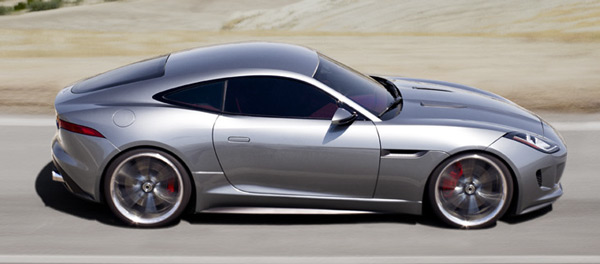
HYBRID TRANSMISSION
The C-X16 signposts how the next generation of Jaguar sports cars will
produce their power in an environmentally conscious manner. The concept
is powered by an experimental hybrid powertrain that combines an
all-alloy V6 engine with a performance-boosting electric motor with a
“Push-to-Pass” feature inspired by the Formula 1 Kinetic Energy Recovery
System (KERS) system.
The purpose of this prototype hybrid-performance system is threefold: to
supplement the V6 engine’s already prodigious power through an
on-demand ‘Push to Pass’ system; to reduce fuel consumption; and to
allow the C-X16 to perform as a zero-emissions electric vehicle at
speeds of up to 50mph on low throttle openings.
Intelligent Start/Stop
The starting point is Jaguar’s eight-speed transmission with Intelligent
Start/Stop, which recently launched to great acclaim in the XF sports
sedan. The system can shut down the engine in just 300 milliseconds
after the car has come to rest and utilizes a Twin Solenoid Starter that
is capable of restarting it in the time it takes the driver’s foot to
travel from the brake to the accelerator. This provides for faster
recovery and seamless performance.
Energy Recovery
The C-X16 extends the Start/Stop system’s functionality by linking it to
a transmission integrated motor generator mounted as one unit with the
gearbox. This draws power from a 1.6kWh lithium-ion battery pack mounted
behind the seats for perfect weight distribution.
Originally developed for one of the most demanding motorsports
environments, the Kinetic Energy Recovery System (KERS) used by Jaguar
has its inspiration in racing. The battery pack is predominantly charged
through a rear axle electro-hydraulic brake energy regeneration system.
Performance on demand
A dashboard display graphic indicates when the additional boost provided
by the electric motor can be deployed. When charged, a ‘Push to Pass’
boost button mounted on the steering wheel allows access to an
additional 94HP and 173lb ft of torque for up to 10 seconds. Because of
the lag-free nature of an electric motor, this power is instantaneously
available. The battery is constantly and automatically recharged, the
entire system overseen by a Hybrid Vehicle Supervisory Controller.
Both the battery pack and electric motor mounted in the C-X16 are liquid
cooled; preventing performance loss from heat build-up during spirited
use. Additionally, the advanced electronics draw chilled air from the
climate-control system. The AC compressor is electric powered, rather
than engine-driven, to reduce losses. The hybrid system is placed within
the wheelbase of the car to optimize weight distribution and maximize
agility by reducing the polar moment of inertia.
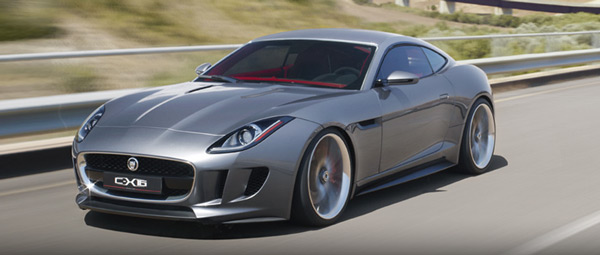
SUPERCHARGED V6
The front-mounted supercharged V6 engine develops 375HP (280kW) and
332lb-ft of torque from a capacity of 3.0-liters. A modular development
of Jaguar AJ-V8, the all-new powerplant points the way to the next
generation of highly efficient, powerful, gasoline fueled internal
combustion engines.
The new V6 uses the same lightweight aluminum architecture as the
eight-cylinder engine with a high-pressure, die-cast block with
cross-bolted main bearing caps for increased strength and refinement.
The dual-cam, four-valve cylinder heads are constructed with recycled
aluminum to reduce the environmental impact of manufacturing.
Optimized for bore and stroke, the V6 also features a second-generation
Direct Injection fueling system with a compression ratio of 10.5:1. An
electronic bypass for the sixth-generation twin vortex Roots-type
supercharger allows much more precise boost control to reduce fuel
consumption.
Performance and Refinement
These advances in efficiency allow the V6 to produce a specific power
output of 125HP per liter. Allied to the performance-boosting electric
motor the result is astonishing – 0-62 mph (0-100kmh) in 4.4 seconds, a
governed top speed of 186 mph and roll-on acceleration of just 2.1
seconds between 50 and 75 mph.
To ensure the powerplant delivers not only the power but also the
refinement that Jaguar cars are famous for, the V6 features a patented
system of independently rotating balancer weights at the front and rear
of the engine. Anyone familiar with the smooth, powerful V8 will find
that the V6 shares all its power delivery and refinement
characteristics, with of course its own stirring soundtrack, while
delivering improved economy and emissions meeting SULEV 30 and EU VI
standards.
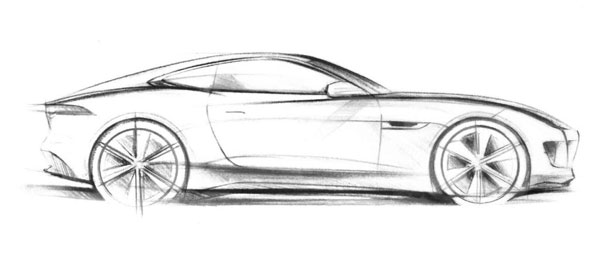
DESIGN
“This car has been designed from first principles. It is an evolution of
the design ethos of past Jaguar cars and defines the agenda for a
future of dramatic, innovative sports cars. Purity of line and intent is
what Jaguar does best.” – Ian Callum, Design Director, Jaguar Cars
If anything can be said to define Jaguar designs it is one word: drama.
The C-X16 is no exception, taking the traditional two-seater sports car
template and redefining it in the Jaguar idiom.
In its simplest form, sports car design is defined by the relationship
between the mechanics and the bodywork. The aim at Jaguar has always
been to wrap the form as tightly as possible around the function to
create a taut, sculpted appearance that could only be that of a Jaguar.
Finished in Gunmetal, there is no wasted space, movement or surface on
the C-X16, every line serves its purpose in creating a whole that is
more than the sum of its parts.
Purity of Line
The C-X16 moves the award-winning Jaguar design language on to the next
level and is startling in its simplicity, defined as it is by three
‘heartlines’ the front fender crease, the rear haunches that wrap into
the tail and the sweeping roofline.
“The stance of this car is everything. It is fundamentally a driving
machine and that has driven every aspect of the design. We have pulled
the three signature heartlines back as far as we can to create a dynamic
tension. The car possesses a sense of latent power; the potential to
leap instantly into action.” – Ian Callum, Design Director, Jaguar Cars
The C-X16 also makes use of newly established Jaguar styling signatures
such as the subtly rounded trapezoidal grille. Inspired by the C-X75
concept car and recognizably related to the current XF and XJ, this is
the focal point for the front end of the car.
Muscular Definition
The muscular clamshell hood is defined at the outer edges by two sharp
creases rising along the upper edges of the front fenders. These begin
in the gill-like strakes dividing the air intakes flanking the grille
before blending away into the shoulder line running along the doors. The
importance of this front fender line is emphasized by the angular form
of the headlights, which deliberately follow the rising fender to lead
the eye up and along the contours of the car rather than cut across
them. The horizontal front fender vents, like those on the hood, are
finished in carbon-fiber.
The defining role of the front fender line is taken up by a further
finely chiseled crease that forms a double curve, swelling outwards and
upwards from the waist of the car to encompass the muscular haunches
that are a Jaguar hallmark. This feature line then swoops, unbroken,
round the rear of the car to create the tail, which mimics the
appearance of the trailing edge of a swept aircraft wing.
The rear lights continue the theme set with the C-X75 by extending
around the flanks of the car immediately below the tail crease to
literally highlight the powerful width of the rear track and, like the
grille, provide instant recognition that this is a Jaguar sports car.
Aerodynamic Simplicity
In order to retain the unblemished muscularity and uninterrupted airflow
along the flanks of the car, the door handles are entirely flush with
the bodywork. Touch sensors built into the handles trigger silent
electric motors, which present the machined aluminum handles to driver
and passenger.
The same desire for stunning simplicity has driven the aerodynamic
element of the C-X16 sports car’s design with no unnecessary wings or
spoilers. Down force is provided by a discreet front splitter,
Venturi-effect tail design and side sills to channel air smoothly along
the car’s flanks, all of which are finished in carbon fiber. The sharp
crease created where the curve of the roof meets the tail also aids the
aerodynamics by ensuring the air separates cleanly from the bodywork at
high speed.
Even standing still, the sense of purpose and power inherent in the
C-X16 is unmistakable thanks to a stance that optimizes the relationship
between the bodywork and the 21-inch alloy wheels which have been
pushed to the extremes edges of the car and finished with a carbon-fiber
inlay.
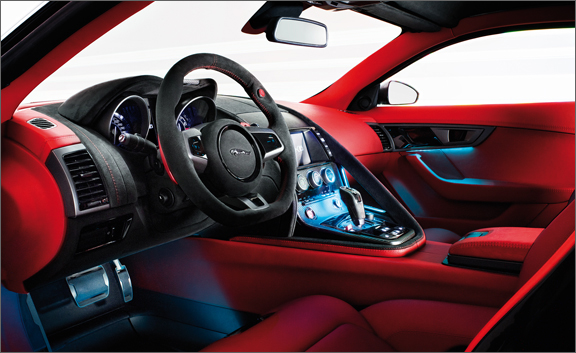
INTERIOR
The singularity of purpose exhibited by the exterior styling of the
C-X16 is reinforced the moment the door is opened, whereupon driver and
passenger are greeted by a dramatic red interior trimmed in the finest
materials; leather, Suedecloth, anodized machined aluminum, carbon-fiber
and dark chrome.
Vermillion Red Interior
The car is clearly centered around the driver and underlines its ‘One
plus One’ layout by deliberately creating as cocooned and cosseting a
space as possible. The heart-stirring potential of the C-X16 is
underlined by the choice of visceral Vermillion Red as the primary color
and trim theme throughout.
Aircraft-inspired Layout
The C-X16 takes inspiration for elements of its layout from aeronautical
ergonomics, such as the joystick-style gearlever and banks of toggle
switches that also reference classic racing Jaguar cars. As a result of
this thinking the dashboard has been shrink-wrapped around the driver to
provide the best view forward, allowing the car to be placed with
absolute precision in corners, aided by the sharp creases on top of the
front fenders.
The desire to keep the top of the dashboard as unadorned as possible led
to the creation of an Intelligent Venting System. Governed by complex
algorithms built in to the advanced climate control, this double vent –
inspired by the intakes on the Typhoon fighter jet – deploys out of the
dash to provide an intense blast of hot or cold air as needed to rapidly
alter the cabin temperature and then discreetly retracts when the
desired level is reached.
In the same way that the exterior door handles are concealed until
activated, a desire for ergonomic clarity means aspects of the interior
remain ‘secret until required’. Pushing the starter button initiates an
aircraft-inspired starting sequence that powers up the hidden-until-lit
displays in a cascade down the center console. What looks at first sight
like a TFT screen in front of the driver is revealed to be an elegant
twin-dial instrument panel, a hallmark of Jaguar sports cars, hidden
behind a smoked glass panel.
Dual-function Switchgear
With Jaguar already a leader in touchscreen technology, the C-X16
features the next generation of the system, augmenting the central
screen with two rows of ‘Home’ keys on either side that provide
shortcuts to top-level menu functions. Further controls take their
inspiration from devices such as smartphones and tablets and provide
multimodal functionality.
The rotary heating controls are made from machined aluminum and anodized
in dark gunmetal; traditional materials, but in the center of each is a
miniature OLED display which reconfigures according to how the controls
are used. Rotating the controls alters the temperature on respective
sides of the car but pushing them changes their functionality; they now
control the heating and cooling functions of the seats.
The switchgear is framed in carbon-fiber and features subtle
‘watch-like’ dark chrome highlights while the gearlever and dynamic mode
selector switch are surrounded by red anodized aluminum to emphasize
their purpose.
Connectivity
The center console armrest houses the Jaguar ‘Connect and View’ system.
This system allows smartphones from a range of manufacturers to be
plugged into the machined aluminum tray between the front seats,
whereupon the central touch-screen reconfigures to reflect that device’s
display. The system will communicate with the majority of the
smartphone’s functions, alerting the driver to appointments, providing
navigation instructions, reading out emails and texts and, of course,
making and receiving phone calls.
Carbon-fiber construction
Made from lightweight composite materials the close-fitting and
supportive racing seats feature manual adjustments to further reduce
weight. A central carbon-fiber spine runs up the center of each seatback
to reinforce it.
The structural properties of carbon-fiber are further utilized in a
bracing bar that flows back from the center console dividing the seats
and then splits in two, before being bolted to the rear suspension
turrets to provide additional rigidity. Further carbon-fiber is found in
the center console, framed by the tailored passenger grab handle that
flows organically from the dashboard to the transmission tunnel. The
floor is finished in aluminum and black Poltrona Frau leather that has
been subtly hand quilted with a Hex pattern influenced by the historic
Jaguar logo – this same motif is found stitched into the Suedecloth
headlining.
Nestled discreetly behind the front seats are the lithium-ion battery
pack and inverter that provide power to the hybrid drive system.
Positioned here for optimum weight distribution, they are hidden under a
cover machined from solid aluminum and designed with integral heat
sinks.
